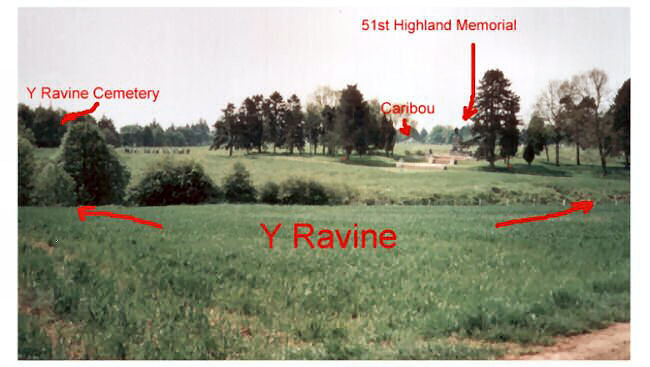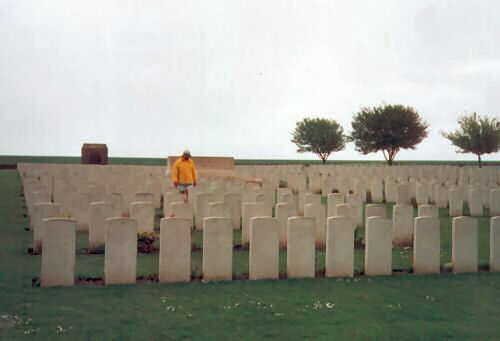
1838x716 148KB
Looking back over Y Ravine towards the Memorial Park
ALBERT BARKER
15th Battalion Durham Light Infantry
At Miraumont August 1918
Along with a friend or two I try to get to the western front a couple of times a year.
On this occasion the visit was made more memorable, because the visit had a clear purpose.
Albert Barker was a Lincolnshire man born in 1898. He came from a large family and during
his childhood, the young boy was farmed out to live with various relatives. As the family
had over ten children, Albert had to survive on his wits. He eventually went to live
with his eldest sister when he started work at fourteen. Albert was called to the colours in
1917 and he was drafted into the 15th Battalion Durham Light Infantry.
He was killed in action on 24th of August 1918 and is remembered on the Vis-En-Artois Memorial.
He officially has no known grave.
Two of my companions travelling to the Somme on this visit -
brothers Jon & Steve - were related to Albert, a Great Uncle.
Jon has long hoped to locate the most likely place that Albert could be buried, assuming he was buried.
The battle he died in was so close to the end of the war that we felt it was probable that
Albert was in an Unknown Grave, unless of course his body was destroyed or buried in battle.
We hoped to find some Unknown Soldiers of the Durham Light Infantry killed in action on
24th of August 1918 buried along side 15th Battalion Durham Light Infantrymen killed in the
same action as Albert.
We caught the 06:20 shuttle and headed down towards the town of Albert.
On arriving in Albert we headed for a Cafe opposite the famous Basillque, nothing like french coffee!.
We then visited the tunnels underneath the Basillque now the Musee des Abris which were full
of interesting artifacts.

1838x716 148KB
Looking back over Y Ravine towards the Memorial Park
We followed the track past Y Ravine then down the track into Beaumont Hamel. The guide was excellent and added depth and greater understanding of the area we were walking through. Albert was at beaumont on the 21st of August 1918, He moved to a position just east of the village through a storm of high explosive shells. When we got to the civilian cemetery we followed the guide up a track to the right of it, this took us through the German front lines and down towards the infamous "gully" It was from the other side of the gully that the Royal Naval Division went over the top on the 13th November 1916. Walking down the track we found shell fragments laying on the surface by the bucket load (a momento of the day). At the end of the track is the Ancre British Cemetery, Here I visited the grave of Frederick Gee one of the Sittingbourne boys who died in the November battle mentioned above (see roll of honour). The walk would have taken us up to Beaucourt but alas we had other things to do (next time perhaps!)
Albert Barker moved up in the evening of the 22nd to a ravine just north of the ruins of Beaucourt. Here the 15th Battalion relived a battalion of East Yorks Territorials. The 64th Brigade of whom the 15th Bat tailion DLI was attached had already bridged the Ancre but the Germans still held the high ground at Thiepval ridge. The brigade had been given the task to wrest the high ground south of Miraumont from the grasp of the enemy. At 23:30 on the 23rd of August carrying no unnecessary equipment the 15th Battalion formed up under heavy fire and an hour later advanced up hill towards Miraumont. They advanced steadily in Artillery formation with the Durhams on the right flank. The Germans fought obstinately in Battery Valley, but the Durham's and Yorkshires pushed on with grim determination. Once the Kings Own Yorkshire Light Infantry had over run and crossed the Grandcourt to Courcellet Road the attack slowed while the battalions regrouped. The advance resumed at 03:30 am one hour before daylight, they had a mile and a half to go before they would reach the final objective. The ground to the left was easier going so that the Kings Own Yorkshire Light Infantry arrived at the final objective first, the Durham's were ten minutes behind. Jon and Steve have searched Grandcourt Cemetery and a few others looking for fellow 15th Bn Durham light Infantry men who died the same day as Albert, hoping there would be one or two DLI Unknown's amongst them. With my copy of Soldier's Died, I discovered 43 men from the 15th Battalion who were killed on 24th August 1918 the day Albert died, about 19 have no known grave the rest apart from two were buried at Regina Trench Cemetery. Jon also suspected this to be a good place to look for unknown DLI graves. When we arrived at the cemetery the heavens opened up and what had been a lovely spring day became a cold wet miserable one.

1516x1034 213KB
Searching Regina Trench Cemetery
At Point Miraumont the battalions reorganized themselves. Some Germans came out of Boom ravine and signaled to the British to surrender, but they were soon dispersed with rifle fire. At 08:00 am the Germans counter attacked from Miraumont they crossed the river but withered against a hail of machine gun and rifle fire, another attempt from Boom ravine was dealt with in a similar fashion. At some point during the attack detailed above Albert Barker was killed. We wandered along the rows of gravestones until we found the men of the Durham Light Infantry who died that day. There they were, all these men Albert would have know them, been friends with and shared his good and bad times with them in the final months of his and their lives. Among them were unknowns but none had the DLI badge just known unto God? This was a bit disappointing, especially for Jon & Steve who had wanted to believe Albert lay there amongst his comrades. But the strange thing was that here was a row of men from the same Battalion as Albert and all of them killed on the same day, yet dispersed amongst them were Unknown graves.
We talked ab out it in the car afterwards. Why were their no DLI unknowns, there were plenty of other regiments there with unknown soldiers buried beneath a regimental badge? One theory which we all decided was the most likely, was that some of the 43 DLI's killed that day were probably killed by shellfire. When the clearing parties buried the dead after the battle all the bodies and body parts would have been buried in a small cemetery somewhere over near the battle at Miraumont. After the war when the smaller cemeteri es were closed and the bodies centralised to bigger sites, perhaps some of the bodies had lost their badges etc. I think the fact that these unknown soldiers are buried amongst the DLI's who died that day would indicate that they came from the same original burial plot. I think Albert is buried at Regina Court Cemetery.... We headed up to Ypres to finish the day at the Menin Gate after some wonderful Flemish stew. At eight o clock we stood at the Menin Gate, I looked up at all those names. We knew we would never find Albert but we found his friends we walked in his footsteps and we remembered him eighty three years after his death.
Steve McGarry 2001